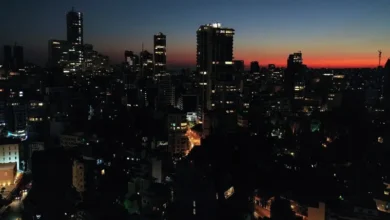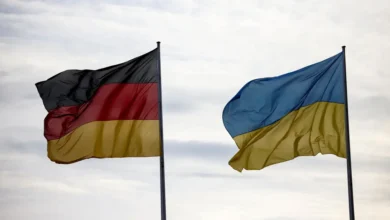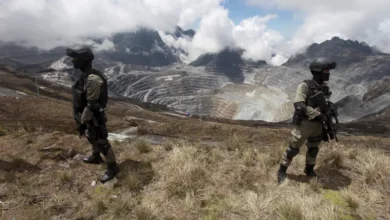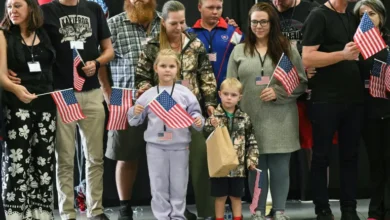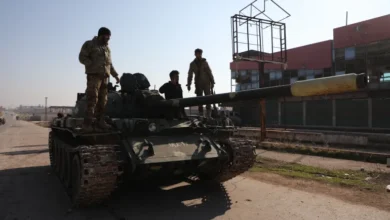How an Afghan girls’ school principal fled the Taliban

On a cold November day, Aqila Tavakali and her 14-year-old son brace themselves against an icy wind as they walk the several blocks from their temporary apartment to his new school.
Abolfazl says goodbye to his mother at the corner, and Aqila watches as he disappears through the yawning doors of the main entrance.
Newtonbrook Secondary, just north of Toronto, Canada, sprawls across an entire city block. More than 2,000 students from grades eight to 12 attend the school.
With basketball courts, a swimming pool and a large auditorium, the school offers the type of education 44-year-old Aqila could only dream of providing when she was principal at a girls’ school in Kabul, Afghanistan until October 2021.
She wipes a tear from her eye in a futile attempt to stem a torrent from streaming down her cheeks.
“Not a day goes by that I don’t think about my students at Sayed ul-Shuhada,” she told Al Jazeera. “They were very poor economically, but they were also very smart.”
Aqila, her husband Musa, a 47-year-old former taxi driver in Kabul, and their three children, aged nine, 14 and 22, are among the estimated 1.2 million Afghans who fled their country after the Taliban seized power in August 2021.
In Afghanistan, Aqila had dedicated herself to improving conditions for her female students. Sayed ul-Shuhada was one of only a few high schools in the Hazara neighbourhood of Kabul. More than 7,000 girls attended the school in three shifts a day, from grades one to 12.
When Aqila was appointed principal in 2013, girls were hungry for education, but resources for them were scarce. They took classes outside, sitting on the ground in the elements while boys were taught in classrooms indoors. So Aqila embarked on a years-long fundraising campaign to construct new buildings for the growing number of female students.But the Taliban did take Kabul, and took over the rest of the country, in August that year, and almost immediately stopped all girls from attending high school. Aqila did several interviews with Afghan media, calling on the group to reopen schools for older girls. Her relatives worried that she was putting herself, and her family, in greater danger. When the threats started to come more frequently, she decided she had no choice but to leave.
“It was really hard for me,” she confessed. It would be the second time Aqila fled her country. She had left for Iran with her parents and siblings when she was a teenager in 1994 as the Taliban rose to power, returning in 2005, four years after the US invasion that toppled their rule. “When Hamid Karzai became president [in 2001], he asked people to please come home and rebuild. And I was one of those many thousands of refugees who came back to Afghanistan with the hope of rebuilding the country.”
This time, though, getting out of Afghanistan would prove to be one of the biggest challenges Aqila has ever confronted. Despite numerous attempts – including by foreign acquaintances – to get the family on the manifests of the foreign airlifts, it proved impossible. And going to the airport was growing more dangerous by the day.
In the days leading up to the final withdrawal of Western forces on August 30, 2021, the world watched in horror as heartbreaking scenes were broadcast from Kabul airport. Tens of thousands of desperate Afghans crowded outside, some climbing over the blast walls and hanging onto the wheels of evacuation flights taking off, before falling to their deaths.
After the final flights left, opportunities to flee the country dissolved.
Aqila became discouraged. The Taliban issued a decree that all women in senior positions should stop going to work. But she resisted and returned to Sayed ul-Shuhada to run the primary school for the younger girls.
‘We just ran to the border’
Their plight captured the attention of Canadian journalist Brennan Leffler. That September, he, along with a group of friends, decided to apply to a government programme that allows Canadians to sponsor and resettle refugees, with an upfront pledge of their own money that would support the family through their first year. The programme was set up years earlier to help settle Syrian refugees; the group of friends was advised to apply in anticipation that the government would revive it to help the 40,000 Afghans Prime Minister Justin Trudeau had committed to bring to Canada.
Then they connected with a non-profit organisation, Journalists for Human Rights, that worked to bring at-risk Afghans to Canada. Their list already had 500 names on it. It seemed overwhelming. But Brennan managed to get Aqila and her family’s names on this list.
The greatest challenge was getting the family out of the country when thousands of people were desperately trying to do the same thing. Seats on private flights were promised by various private citizens and NGOs who were organising them, then cancelled at the last minute without giving reasons, as they waited with their bags packed to go to the airport.
With options to leave dwindling by the day, the non-profit helped them get visas to Pakistan in October 2021, after two excruciating months of waiting, and arrangements were made to drive them from Kabul to Islamabad. They quietly sold their home and most of their belongings, and Aqila said goodbye to her colleagues at Sayed ul-Shuhada. And then, in the early morning hours one day in late October, a car came to pick them up from their home to take them out of the city. Exhausted, worried, and fearful of the Taliban guards at the border, they waited in line at the Torkham crossing for eight tense hours before their passports were finally stamped and they were waved through.
“There’s about 10 metres to the border,” Aqila recalled, “and when we got our passports back, we were so happy we just ran the 10 metres to the Pakistan side. And we finally could breathe.”
In Pakistan, the family stayed at a guesthouse with other Afghans who had fled. The non-profit that helped them leave Afghanistan covered most of their expenses since they were unable to work or go to school in Islamabad.
Their first weeks in the city were spent sightseeing and enjoying the freedoms that were being taken away from them back in Afghanistan. But as weeks turned into months with no word on when they might get to Canada, a sense of unease crept in. What if their sponsors’ application was rejected? “We started thinking, what if this doesn’t work? What if we can’t get to Canada? Would we have to go back to Kabul? Because we lost everything. We can’t go back.”
In Toronto, Brennan was growing more frustrated by the day. “We were trying everything,” he said. “I mean, I was trying all my sources. I had a former military person who was based in Kabul who knew some people [in the Canadian government] and was pushing them. But no one was getting anyone out. There was a group of Canadian generals who were trying to get people who had worked with them and risked their lives during the war and they couldn’t get them out.”
How Afghans are treated versus Ukrainians
When Russia invaded Ukraine in February 2022, Canada’s focus shifted to accelerating the process for Ukrainians fleeing their homeland. More than 140,000 Ukrainians have since arrived in Canada, with close to half a million applications approved, leading to accusations that the government has a two-tiered refugee system.
“They allowed Canadians to bring [Ukrainians] in on their own accord,” Brennan pointed out. “And they were giving out visas for Ukrainians to get here within days, which I think is great. I think that that’s how it should have been for Afghans, as well.”
